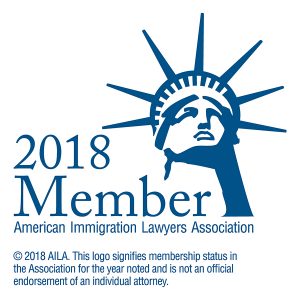Menu
DOS's Charlie Oppenheim Weighs in on February Visa Bulletin
January 24th, 2018
Every month, the Chief of the Visa Control and Reporting Division of the Department of State, Charlie Oppenheim, talks with the American Immigration Lawyers Association about the visa bulletin. AILA publishes the interview monthly (AILA Doc. No. 14071401). After the release of the February 2018 Visa Bulletin, Oppenheim discusses the bulletin by category.
Oppenheim's Take on Employment-Based Categories:
EB-4 Religious Workers and EB-5 Regional Center Categories "Unavailable."
Congressional authorization for the EB-4 Religious Workers (SR) and EB-5 Regional Centers (I5 and R5) categories will sunset on February 8, 2018, if not reauthorized by Congress. If the SR categories are reauthorized, EB-4 (SR) will become current for February except for EB-4 El Salvador, Guatemala and Honduras, which will have a final action date of December 1, 2015, and EB-4 Mexico which will have a final action date of June 22, 2016. If the I5 and R5 categories are reauthorized, "the final action dates would immediately become 'Current' for February for all countries except China-Mainland born I5 and R5 which would be subject to a July 22, 2014 final action date."
EB-5 China (Non-Regional Center).
The EB-5 China (Non-RC) category will hold at July 22, 2014, in February. Charlie predicts that the EB-5 (Non-Regional Center) category will remain current in the coming months except for EB-5 China, which will experience little if any forward movement.
EB-5 Vietnam.
A final action date will be imposed for EB-5 Vietnam no later than April, and that date will track the EB-5 China final action date. While Charlie predicted in the spring of 2017 that a final action date for EB-5 Vietnam would be required, based on demand patterns at that time, he did not anticipate that this would happen until late FY 2018. Charlie noted the possibility of a new final action date for EB-5 Vietnam at conferences in the spring and fall of 2017. The publicization of this issue may have prompted the immediate increase in action on EB-5 Vietnam cases at the NVC, resulting in the earlier than expected imposition of a final action date.
EB-1 India and EB-1 China.
The imposition of a final action date for EB-1 China and EB-1 India in late FY 2017 created pent up demand which was largely adjudicated in the first quarter of FY 2018. So far, this fiscal year, EB-1 India and EB-1 China have already used 7,000 and 4,500 visa numbers, respectively. Charlie expects these categories to remain current for the coming months, but the imposition of a final action date in the summer remains likely if the current rate of demand continues. This could, however, be delayed if the transition of I-485s to USCIS Field Offices results in slowed processing of EB-1 China and EB-1 India cases in the coming months.
EB-2 Worldwide.
This category should remain current for the foreseeable future.
EB-2 and EB-3 China.
In February, EB-2 China will advance just under two months to October 1, 2013, and EB-3 China will advance five months to September 15, 2014. The February Visa Bulletin predicts that EB-2 China will continue to advance at a rate of "(s)everal months." Charlie clarified that this means advancement at a rate of two to three months, noting that EB-2 China may move at a faster pace to generate demand. EB-3 China is predicted to advance at a pace of "(u)p to five months." Charlie advised that EB-3 China will likely continue to advance at a faster pace than EB-2 China.
For the past few fiscal years, the EB-3 China downgrade phenomenon spurred sufficient EB-3 demand to ultimately cause the EB-3 China final action date to advance to a more favorable final action date than EB-2 China. It is unclear whether this "flip" will occur in FY18 due to a combination of factors, including the availability of otherwise unused family-based preference numbers for China, and uncertainty as to how the transfer of employment-based I-485s to USCIS Field Offices will impact the speed of adjudications and the processing of upgrade and downgrade requests.
EB-2 and EB-3 India.
EB-2 India. Consistent with Charlie's predictions, EB-2 India will again advance by less than one month in February from November 22, 2008, to December 8, 2008. Given heavy demand, the February Visa Bulletin predicts modest forward movement for EB-2 India at a rate of "(u)p to two weeks."
EB-3 India. The final action date for EB-3 India will advance one month from November 1, 2006, to December 1, 2006. The February Visa Bulletin predicts forward movement in this category at a pace of one to three months. Once the final action date advances beyond August 2007, Charlie will have very little visibility into demand. Once this occurs, there is the potential for rapid movement of the EB-3 India final action date to generate new demand. Members may see this happen next fiscal year or possibly even later this fiscal year.
EB-3 Philippines.
This category will advance two weeks to March 1, 2016, in February. Demand in this category is comfortable, but not extremely high, which means there is less room to advance this date significantly. Charlie is watching this category closely since there have been spikes in demand, and he does not want to advance the final action date too quickly to avoid future retrogression. At this time, demand in this category is heavily weighted toward consular processing, but it is expected that USCIS filings could increase significantly in the coming months.
EB-4. As noted above, a sub-category of EB-4, Religious Workers will become unavailable as of January 19, 2018, unless reauthorized by Congress.
The final action date of December 1, 2015, for EB-4 El Salvador, Guatemala, and Honduras continues to hold, while EB-4 Mexico advances approximately three weeks to June 22, 2016, in February. EB-4 Mexico demand is relatively consistent, and this category is still within its per country limit. However, Charlie expects EB-4 Mexico to exhaust its per country limit in June, at which time a final action date will be imposed, tracking that of EB-4 El Salvador, Guatemala, and Honduras. EB-4 India remains current, but Charlie expects that in the summer, a final action date will need to be imposed.
Similar to EB-2 India and EB-3 India, Charlie has visibility into significant pre-adjudicated demand filed when EB-4 was "Current." This enables him to slowly advance the final action dates, minimizing volatility and the risk of retrogression.
Last fiscal year, more than half of the 9,940 available EB-4 numbers were used by Special Immigrant Juveniles (SL6). Although there is very high SL6 number usage by El Salvador, Guatemala, Honduras, and Mexico, it should be noted that almost every country in the world uses SL6 visa numbers
Oppenheim's Take on Family-Based Categories
Final action date movement tends to be less erratic and more predictable in the family-based categories since Charlie has greater visibility into demand patterns based on the use of "dates for filing," and the fact that these cases are primarily adjudicated at consular posts rather than domestically by USCIS. The February Visa Bulletin includes predictions for Worldwide family-based cases, with FB-1 Worldwide advancing at a pace of up to one month, FB-2A Worldwide advancing three to five weeks, FB-3 Worldwide advancing up to five weeks, and FB-4 worldwide advancing up to three weeks.
FB-1 Philippines and FB-2B Philippines, which had retrogressed in December, will advance seven months and 21 days in February, respectively. Charlie will continue to monitor demand carefully in these categories over the next several months. Recent volatility is attributable to the lack of visibility of rescheduled appointments made by applicants through the Department of State's Global Support System (GSS). Charlie is working closely with the post in Manila to obtain more accurate demand data, and he hopes that as a result, these dates will slowly advance and recover.
MEMBER QUESTION:
The February Visa Bulletin appears to have been released later than usual. Is there a reason for the delay?
Yes, the Visa Bulletin has been issued slightly later this month than in the past. Previously, once the ALDAC cable with the upcoming month's final action dates (the All Diplomatic and Consular Posts monthly cable regarding visa availability) was sent for clearance, the Visa Bulletin would automatically be released to the public. Recently, a separate process for the Visa Bulletin has been implemented, which has caused slight delays in publication.
Please feel free to contact our office if you have any immigration questions.
Tags: visa bulletin


